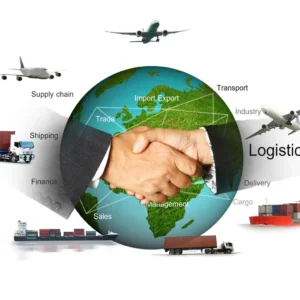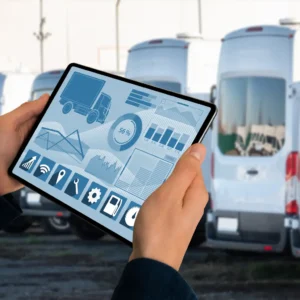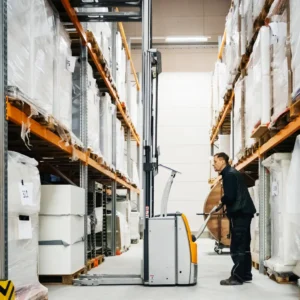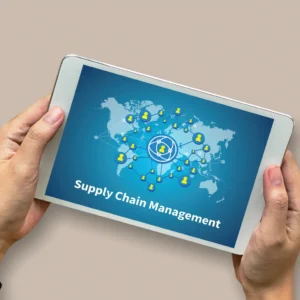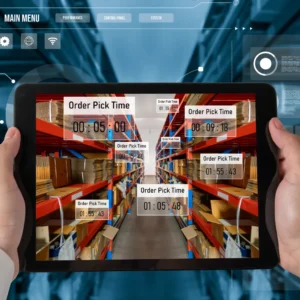
LogiTech Revolution
Navigating the Future with AI Tools in Transportation & Logistics
This article explores AI tools in the Transportation and Logistics industry. These AI-driven solutions offer transformative capabilities, from optimizing routes and managing fleets in real time to enhancing warehouse operations and ensuring compliance.
Integrating artificial intelligence (AI) has brought about a new era of efficiency, sustainability, and innovation in the transportation and logistics industry.
This integration addresses traditional challenges and propels the industry towards heightened resilience, improved customer satisfaction, and a greener, more sustainable future. The strategic adoption of AI technologies is pivotal in shaping the transportation and logistics sector’s competitive edge and future trajectory.
Table of Contents

Arindam Roy
An Automation Consultant with 25+ years of IT Experience
50 AI Tool ideas for Transportation and Logistics industry
The comprehensive list of AI tools below for the Transportation and Logistics industry covers various functionalities, addressing multiple aspects of the supply chain and logistics operations. Here’s a summary of the essential tools and their examples:
Route Optimization and Planning:
- AI-Powered Route Planning
- Real-Time Traffic and Weather Updates
- Dynamic Fleet Management
- Last-Mile Delivery Optimization
- Automated Load Balancing
Warehouse Management and Automation:
- AI-Powered Inventory Forecasting
- Autonomous Inventory Drones
- Automated Order Picking and Packing
- Predictive Maintenance for Equipment
- AI-Enhanced Slotting Optimization
Fleet Maintenance and Monitoring:
- Predictive Maintenance for Vehicles
- Fuel Efficiency Optimization
- Driver Behaviour Analytics
- Automated Vehicle Inspection
- Telematics for Fleet Tracking
Order and Shipment Tracking:
- AI-Driven Shipment Visibility
- Automated Proof of Delivery
- Predictive Delay Notifications
- Smart Package Tracking
- Shipment Risk Assessment
Supply Chain Visibility and Collaboration:
- AI-Powered Supply Chain Analytics
- Collaborative Demand Forecasting
- Blockchain for Supply Chain Transparency
- Automated Supplier Performance Monitoring
- Smart Contracts for Logistics Agreements
Sustainability and Green Logistics:
- Eco-Friendly Route Planning
- Carbon Footprint Tracking
- Green Packaging Recommendations
- Alternative Energy Adoption Analysis
- Sustainable Sourcing Guidance
Compliance and Regulatory Support:
- Automated Compliance Checks
- License and Permit Management
- Customs Documentation Automation
- Regulatory Change Alert System
- Trade Agreement Compliance Checker
Risk Management and Security:
- Cargo Security Monitoring
- Fraud Detection in Logistics
- Real-Time Incident Response
- Biometric Authentication for Access
- AI-Enhanced Cybersecurity
Predictive Analytics and Business Intelligence:
- AI-Powered Demand Forecasting
- Predictive Pricing Analytics
- Customer Behaviour Analysis
- Market Trends and Competitor Analysis
- Financial Performance Prediction
Operational Efficiency and Automation:
- AI-Powered Workforce Management
- Automated Document Management
- Invoice and Billing Automation
- AI-Enhanced Equipment Utilization
- Predictive Warehouse Space Management
This well-rounded set of tools covers everything from optimizing routes and managing inventory to ensuring compliance and enhancing security. It also incorporates sustainability and addresses various aspects of predictive analytics to improve decision-making and overall operational efficiency in Transportation and logistics.
AI Tools for Route Optimization and Planning
Business Knowledge Requirements
Understanding transportation logistics, geographical factors, and traffic patterns is crucial. Knowledge of vehicle types, fuel efficiency, and delivery constraints is essential for effective AI tools for Route Optimization and Planning in the Transportation and Logistics industry.
Technical Knowledge Requirements
Technical knowledge in algorithms, optimization techniques, and machine learning is essential for developing AI-powered route planning. Real-time traffic and weather API integration require data processing and API integration proficiency. Dynamic Fleet Management involves real-time data analytics, GPS tracking, and algorithmic decision-making expertise. Last-mile optimization and load balancing demand knowledge in spatial analytics and logistics modelling.
Technical Tools Already available in this domain
Existing tools in route optimization leverage algorithms and machine learning for AI-powered route planning. Applications integrating GPS data and weather APIs facilitate real-time traffic and weather updates. Dynamic fleet management tools utilize real-time data analytics and optimization algorithms. Last-mile delivery optimization tools use route optimization algorithms, while automated load-balancing solutions optimize vehicle distribution dynamically.
Integration Knowledge needs for existing products
Integrations for AI-powered route planning include:
- Real-time traffic and weather data APIs.
- GIS (Geographic Information System) for mapping.
- IoT devices on vehicles for dynamic fleet management.
Seamless integration with navigation systems ensures accurate implementation.
Training Requirements for existing staff to use the new tools
Training for AI-powered route planning involves educating staff on using route optimization algorithms and understanding the integration of real-time traffic and weather updates. Dynamic Fleet Management training includes teaching operators how to interpret and act upon real-time data for optimizing fleet deployment. Last-mile delivery Optimization requires instruction on leveraging AI algorithms for efficient last-mile route planning. Automated load Balancing training focuses on understanding load distribution principles and utilizing automated tools for optimization.
Challenges and workarounds
- Challenges: The dynamic nature of traffic and weather conditions poses challenges for AI-powered route planning. Rapid changes may lead to suboptimal routes.
- Workaround: Continuous updates and real-time integration with reliable traffic and weather APIs can mitigate these challenges.
Cost and Benefit Analysis
- Costs: Initial investment in AI algorithms and integration.
- Benefits include:
- reduced fuel costs,
- improved delivery efficiency,
- lower environmental impact.
AI Tools for Warehouse Management and Automation
Business Knowledge Requirements
A deep understanding of inventory management, demand forecasting, and warehouse operations is necessary. Knowing about robotics, drone technology, and slotting optimization principles helps set up automated order picking and packing. These skills can aid in the implementation of computerized systems.
Technical Knowledge Requirements
AI-powered inventory forecasting necessitates time series analysis, machine learning, and data modelling skills. Implementing autonomous inventory drones requires expertise in drone technology, computer vision, and integration with inventory systems. Automated order picking and packing systems require robotics programming and machine vision knowledge. Predictive maintenance for equipment involves sensor data analysis and machine learning.
Technical Tools Already available in this domain
AI-powered inventory forecasting tools employ machine learning algorithms to predict inventory needs. Autonomous inventory drones utilize drone technology, computer vision, and inventory management systems. Automated order picking and packing tools incorporate robotics and machine vision. Predictive maintenance tools analyze equipment sensor data for proactive maintenance scheduling. AI-enhanced slotting optimization utilizes algorithms to optimize product placement within warehouses.
Integration Knowledge needs for existing products.
AI-powered inventory forecasting requires integration with historical sales data and supply chain information. Autonomous inventory drones need integration with warehouse management systems (WMS) and RFID technology. Automated order picking and packing tools may integrate with e-commerce platforms and ERP systems. Predictive maintenance for equipment involves integrating with IoT sensors and maintenance databases. AI-enhanced slotting optimization requires connectivity with WMS for product information.
Training Requirements for existing staff to use the new tools
Staff needs training on AI-powered inventory forecasting to comprehend algorithmic predictions and leverage them for inventory management. Operating autonomous inventory drones requires training in drone technology, computer vision, and integration with inventory systems. Automated order picking and packing training involves understanding robotic systems and their integration with order fulfilment processes. Predictive Maintenance for Equipment requires educating maintenance staff on interpreting predictive analytics for proactive equipment maintenance. AI-enhanced slotting Optimization training emphasizes the use of algorithms to optimize warehouse layout.
Challenges and workarounds
- Challenges: Implementing autonomous inventory drones may need help with airspace regulations and safety concerns.
- Workaround: Collaboration with relevant authorities, adherence to regulations, and implementing safety measures can help overcome these challenges.
Cost and Benefit Analysis
- Costs: Implementation of AI-powered systems and autonomous drones.
- Benefits include:
- Enhanced inventory accuracy.
- Reduced labour costs.
- Increased order fulfilment efficiency.
- Improved overall operational costs.
AI Tools for Fleet Maintenance and Monitoring
Business Knowledge Requirements
Knowledge of vehicle maintenance schedules, fuel efficiency parameters, and driver behaviour metrics is required. Expertise in telematics and real-time tracking helps in managing fleet operations efficiently to build AI Tools in the Transportation and Logistics Industry.
Technical Knowledge Requirements
Predictive vehicle maintenance relies on IoT sensors, data analytics, and machine learning algorithms. Fuel efficiency optimization demands expertise in data analytics and optimization techniques. Driver behaviour analytics requires telematics, machine learning, and behaviour modelling knowledge. Automated vehicle inspection involves computer vision and sensor integration. Telematics for fleet tracking requires GPS technology and real-time data processing.
Technical Tools Already available in this domain
Predictive maintenance for vehicles involves IoT sensors and machine learning algorithms. Fuel efficiency optimization tools use data analytics to provide recommendations. Driver behaviour analytics tools monitor and analyze driver behaviour using telematics data. Automated vehicle inspection tools employ computer vision for real-time inspections. Telematics for fleet tracking utilizes GPS technology and real-time data processing.
Integration Knowledge needs for existing products
Predictive maintenance for vehicles integrates with vehicle sensor data and maintenance databases. Fuel efficiency optimization tools may integrate with vehicle telematics and fuel consumption data. Driver behaviour analytics tools integrate with telematics and GPS systems. Automated vehicle inspection tools require integration with vehicle diagnostic systems. Telematics for fleet tracking integrates with GPS technology and real-time data processing.
Training Requirements for existing staff to use the new tools
Training for Predictive Maintenance for Vehicles involves educating maintenance personnel on interpreting predictive analytics for proactive vehicle maintenance. Fuel Efficiency Optimization requires training drivers and staff to optimize fuel consumption based on AI recommendations. Driver Behaviour Analytics training focuses on educating drivers and fleet managers on using telematics data for safer and more efficient driving. Automated Vehicle Inspection training is necessary for maintenance staff to operate and interpret results from AI-powered inspection systems. Telematics for Fleet Tracking requires training in GPS technology and real-time data monitoring for fleet managers.
Challenges and workarounds
- Challenges: Predictive maintenance for vehicles relies on accurate data, and inconsistent or incomplete data may affect the reliability of predictions.
- Workaround: Regular data validation and maintenance and predictive analytics refinement can enhance the accuracy of maintenance predictions.
Cost and Benefit Analysis
- Costs: Investment in predictive maintenance systems and telematics.
- Benefits include:
- minimized vehicle downtime
- optimized fuel consumption
- improved driver behaviour
AI Tools for Order and Shipment Tracking
Business Knowledge Requirements
Comprehensive knowledge of logistics operations, real-time tracking technologies, and shipment risk assessment factors is vital. Understanding proof of delivery processes and predictive delay analysis contributes to effective tracking systems.
Technical Knowledge Requirements
AI-driven shipment visibility involves real-time tracking systems and data analytics. Automated proof of delivery requires image recognition and verification algorithms. Predictive delay notifications rely on historical data analysis and machine learning. Intelligent package tracking involves RFID technology, IoT, and real-time data processing. Shipment risk assessment demands risk modelling expertise.
Technical Tools Already available in this domain
AI-driven shipment visibility tools integrate with tracking systems and leverage data analytics for real-time updates. Automated proof of delivery tools use image recognition and verification algorithms. Predictive delay notification tools analyze historical data for forecasting. Innovative package tracking tools utilize RFID technology and real-time data processing. Shipment risk assessment tools employ risk modelling techniques.
Integration Knowledge needs for existing products
AI-driven shipment visibility integrates with tracking, GPS, and order management systems. Automated proof of delivery tools may integrate with delivery confirmation systems and order databases. Predictive delay notification tools integrate with historical data and order management systems. Intelligent package tracking integrates with RFID systems and logistics platforms. Shipment risk assessment tools integrate with risk management databases.
Training Requirements for existing staff to use the new tools
AI-Driven Shipment Visibility training involves instructing logistics staff on tracking systems and interpreting real-time visibility data. Automated Proof of Delivery training is essential for delivery personnel to use AI-powered systems for accurate delivery verification. Predictive Delay Notifications training educates logistics and customer service teams on interpreting predictions and proactive communication. Smart Package Tracking requires training on RFID technology and real-time data processing for warehouse and logistics staff. Shipment Risk Assessment training involves risk management education for logistics and security personnel.
Challenges and workarounds
- Challenges: Delays predicted in advance might face difficulties due to unexpected occurrences like accidents or natural calamities.
- Workaround: Implementing dynamic algorithms that adapt to real-time events and providing contingency plans can help address unexpected delays.
Cost and Benefit Analysis
- Costs: We propose to combine AI-powered tracking and predictive delay notification systems. This will help us better predict delays and their causes and take proactive measures to address them.
- Benefits include:
- improved customer satisfaction
- streamlined logistics
- reduced costs associated with delayed shipments.
AI Tools for Supply Chain Visibility and Collaboration
Business Knowledge Requirements
An in-depth understanding of supply chain dynamics, collaboration methodologies, and blockchain technology is essential to build AI Tools in the Transportation and Logistics Industry. Knowledge of intelligent contracts and supplier performance metrics is crucial for transparent and collaborative logistics agreements.
Technical Knowledge Requirements
AI-powered supply chain analytics requires data analytics, machine learning, and supply chain modelling skills. Collaborative demand forecasting involves data-sharing platforms and machine learning algorithms. Implementing blockchain for supply chain transparency requires blockchain development expertise. Automated supplier performance monitoring relies on data analytics and machine learning. Smart contracts for logistics agreements involve blockchain programming and contract automation.
Technical Tools Already available in this domain
Supply chain analytics tools powered by artificial intelligence (AI) use machine learning to provide in-depth insights. Collaborative demand forecasting tools facilitate collaboration among stakeholders using shared platforms. Blockchain for supply chain transparency tools utilize blockchain technology for secure and transparent transactions. Automated supplier performance monitoring tools use data analytics to assess and monitor supplier performance. Smart contracts for logistics agreements leverage blockchain for automated and secure contract execution.
Integration Knowledge needs for existing products
AI-powered supply chain analytics integrate with various data sources, including ERP systems, order databases, and external market data. Collaborative demand forecasting tools integrate with shared platforms and ERP systems. Blockchain for supply chain transparency requires integration with existing supply chain systems and partner networks. Automated supplier performance monitoring integrates with supplier databases and procurement systems. Smart contracts for logistics agreements integrate with blockchain platforms and contract management systems.
Training Requirements for existing staff to use the new tools
Training for AI-Powered Supply Chain Analytics involves educating data analysts and supply chain managers on interpreting AI-generated insights. Collaborative Demand Forecasting requires training on collaborative platforms and data-sharing protocols for relevant stakeholders. Blockchain for Supply Chain Transparency training is necessary for supply chain managers to understand and leverage blockchain technology. Automated Supplier Performance Monitoring training, educates procurement staff on interpreting AI-generated supplier performance metrics. Smart Contracts for Logistics Agreements training involves legal and logistics staff understanding and implementing smart contracts.
Challenges and workarounds
- Challenges: Blockchain implementation for supply chain transparency faces challenges related to standardization and collaboration among diverse stakeholders.
- Workaround: Industry-wide collaboration, standardized protocols, and educating stakeholders on blockchain benefits can facilitate smoother implementation.
Cost and Benefit Analysis
- Costs: Implementation of AI-powered supply chain analytics and blockchain.
- Benefits include:
- increased transparency
- streamlined collaboration
- reduced risks
- improved supply chain efficiency
AI Tools for Sustainability and Green Logistics
Business Knowledge Requirements
Environmental awareness and knowledge of sustainable practices are necessary. Familiarity with alternative energy sources, eco-friendly packaging, and carbon footprint tracking contribute to green logistics initiatives.
Technical Knowledge Requirements
Implementing eco-friendly route planning requires knowledge of environmental impact modelling and optimization algorithms. Carbon footprint tracking demands expertise in emissions data analysis. Green packaging recommendations involve knowledge of sustainable materials and packaging optimization. Alternative energy adoption analysis requires understanding renewable energy sources and cost-benefit analysis. Sustainable sourcing guidance relies on knowledge of sustainable supply chain practices.
Technical Tools Already available in this domain
Existing eco-friendly route planning tools utilize optimization algorithms to minimize carbon emissions, while transportation activities are monitored and reported through carbon footprint tracking tools. Green packaging recommendation tools provide suggestions for environmentally friendly packaging options. Alternative energy adoption analysis tools offer insights into the feasibility of adopting green energy sources. Sustainable sourcing guidance tools assist in identifying and sourcing sustainable materials.
Integration Knowledge needs for existing products
Eco-friendly route planning integrates with mapping systems, traffic APIs, and environmental databases. Carbon footprint tracking tools integrate with emissions data sources and transportation databases. Green packaging recommendation tools may integrate with inventory systems and packaging databases. Alternative energy adoption analysis integrates with energy consumption databases and cost-benefit analysis tools. Sustainable sourcing guidance integrates with supply chain databases and sustainability metrics.
Training Requirements for existing staff to use the new tools
Eco-Friendly Route Planning training includes educating logistics staff on optimizing routes for reduced environmental impact. Carbon Footprint Tracking training requires environmental and logistics staff to interpret emissions data and reports. Green Packaging Recommendations training involves educating packaging and logistics staff on environmentally friendly packaging options. Alternative Energy Adoption Analysis training is essential for energy and logistics teams to understand the feasibility of adopting green energy sources. Sustainable Sourcing Guidance training requires procurement staff to identify and source sustainable materials.
Challenges and workarounds
- Challenges: Adoption of alternative energy sources may face challenges related to infrastructure readiness and cost considerations.
- Workaround: Conducting feasibility studies, incentivizing adoption, and collaborating with renewable energy providers can address these challenges.
Cost and Benefit Analysis
- Costs: Initial investment in eco-friendly route planning and alternative energy adoption analysis.
- Benefits include:
- reduced carbon footprint
- improved environmental sustainability
- potential long-term cost savings through green practices.
AI Tools for Compliance and Regulatory Support in the Transportation and Logistics Industry
Business Knowledge Requirements
In-depth knowledge of international trade regulations, licensing procedures, and customs documentation is required. Staying up-to-date with regulatory updates and ensuring adherence to trade agreements requires continuous monitoring.
Technical Knowledge Requirements
Automated compliance checks require regulatory knowledge and automation scripting. License and permit management involves database management and automated tracking systems. Customs documentation automation requires expertise in customs regulations and document processing. A regulatory change alert system demands real-time monitoring and notification systems. Trade agreement compliance checker relies on knowledge of international trade regulations.
Technical Tools Already available in this domain
Automated compliance check tools use automation scripts to ensure adherence to regulatory standards. License and permit management tools streamline tracking and renewal processes. Customs documentation automation tools assist in generating and verifying customs documentation. Regulatory change alert system tools monitor changes and provide timely alerts. Tools that check trade agreement compliance are used to confirm whether parties follow the rules and regulations outlined in the agreement.
Integration Knowledge needs for existing products
Automated compliance checks integrate with regulatory databases and compliance management systems. License and permit management tools integrate with licensing databases and regulatory platforms. Customs documentation automation integrates with customs databases and shipment tracking systems. Regulatory change alert system integrates with regulatory monitoring platforms and alert systems. Trade agreement compliance checker integrates with trade databases and compliance systems.
Training Requirements for existing staff to use the new tools
Automated Compliance Checks training involves legal and compliance staff understanding automated systems for regulatory adherence. License and Permit Management training educates relevant personnel on tracking and renewing licenses. Customs Documentation Automation training is crucial for logistics and customs clearance staff to generate and verify documentation accurately. Regulatory Change Alert System training involves compliance teams understanding and responding promptly to regulatory changes. The Trade Agreement Compliance Checker training helps procurement and compliance teams to comply with trade agreements. The training ensures that these teams understand and follow the trade agreements.
Challenges and workarounds
- Challenges: Automated compliance checks must adapt to evolving regulations, requiring constant updates.
- Workaround: Regularly updating compliance algorithms and monitoring regulatory changes can ensure ongoing adherence.
Cost and Benefit Analysis
- Costs: Development and maintenance of automated compliance tools.
- Benefits include:
- reduced risk of non-compliance fines
- streamlined regulatory processes
- improved adherence to industry standards
AI Tools for Risk Management and Security in the Transportation and Logistics Industry
Business Knowledge Requirements
Understanding cargo security protocols, fraud detection methods, and biometric authentication principles is crucial. Real-time incident response and cybersecurity measures safeguard logistics operations.
Technical Knowledge Requirements
Cargo security monitoring requires expertise in security systems and sensor integration. Fraud detection in logistics demands data analytics and anomaly detection techniques. Real-time incident response involves automated protocols and crisis management systems. Biometric authentication for access requires knowledge of biometric technologies and integration. AI-enhanced cybersecurity involves expertise in cybersecurity measures and AI-based threat detection.
Technical Tools Already available in this domain
Cargo security monitoring tools use sensor integration to monitor cargo conditions. Fraud detection in logistics tools analyzes transactions and shipment data for fraud prevention. Real-time incident response tools employ automated protocols for security incidents. Biometric authentication tools control access using AI-enabled biometric systems. AI-enhanced cybersecurity tools implement AI-driven measures to protect logistics data and systems.
Integration Knowledge needs for existing products
Cargo security monitoring integrates with security systems and IoT sensors. Fraud detection in logistics integrates with transaction databases and fraud prevention platforms. Real-time incident response tools integrate with security systems and incident management platforms. Biometric authentication for access integrates with biometric databases and access control systems. AI-enhanced cybersecurity integrates with existing cybersecurity infrastructure and threat intelligence platforms.
Training Requirements for existing staff to use the new tools
Cargo Security Monitoring training is essential for security and logistics personnel to operate monitoring systems effectively. Fraud Detection in Logistics training involves educating finance and security staff on interpreting transaction data for fraud prevention. Real-time incident Response training requires security and operations staff to respond effectively to incidents using automated protocols. Biometric Authentication for Access training educates staff on using and managing biometric access systems. AI-enhanced cybersecurity training involves IT and security teams understanding and implementing AI-driven data and system protection measures.
Challenges and workarounds
- Challenges: Cargo security monitoring and fraud detection may face challenges in recognizing sophisticated threats.
- Workaround: Implementing advanced AI algorithms, collaborating with cybersecurity experts, and continuous training can enhance threat detection capabilities.
Cost and Benefit Analysis
- Costs: Investing in measures that monitor security, detect fraud, and protect against cyber attacks is essential to ensure cargo safety. These investments help mitigate potential risks and ensure smooth operations.
- Benefits include:
- minimized security risks
- enhanced fraud prevention
- safeguarding sensitive logistics data, leading to long-term cost savings.
AI Tools for Predictive Analytics and Business Intelligence in the Transportation and Logistics Industry
Business Knowledge Requirements
A strong foundation in data analytics, market trends analysis, and demand forecasting methodologies is necessary. Knowledge of pricing strategies, customer behaviour analysis, and financial forecasting supports informed decision-making.
Technical Knowledge Requirements
AI-powered demand forecasting requires statistical modelling and machine learning. Predictive pricing analytics demands knowledge of pricing strategies and market analysis. Customer behaviour analysis relies on data analytics and machine learning. Market trends and competitor analysis require expertise in data analytics and market research. Financial performance prediction involves financial modelling and data analysis.
Technical Tools Already available in this domain
AI-powered demand forecasting tools analyze historical data and market trends for accurate predictions. Predictive pricing analytics tools leverage AI-driven algorithms for optimal pricing strategies. Customer behaviour analysis tools use AI to understand and predict customer trends. Market trends and competitor analysis tools monitor market dynamics and competitor activities. Financial performance prediction tools employ AI to predict financial outcomes based on various factors.
Integration Knowledge needs for existing products
AI-powered demand forecasting integrates with sales databases, market data, and ERP systems. Predictive pricing analytics integrates with pricing databases and market analysis tools. Customer behaviour analysis tools integrate with customer databases and CRM systems. Market trends and competitor analysis integrate with market data sources and competitor tracking tools. Financial performance prediction integrates with financial databases and accounting systems.
Training Requirements for existing staff to use the new tools
AI-Powered Demand Forecasting training involves data analysts and sales teams understanding AI-generated demand forecasts. Predictive Pricing Analytics training requires pricing and sales teams to interpret AI-driven pricing recommendations. Customer Behavior Analysis training is necessary for marketing and sales teams to leverage AI-driven customer behaviour analysis insights. Market Trends and Competitor Analysis training involves market analysts and strategic teams understanding and utilizing AI-generated insights. Financial Performance Prediction training requires finance teams to interpret and incorporate AI-generated financial predictions.
Challenges and workarounds
- Challenges: To accurately predict market changes, it may be necessary to use predictive demand forecasting and pricing analytics.
- Workaround: Combining machine learning models that adapt to market volatility and human expertise can enhance predictive accuracy.
Cost and Benefit Analysis
- Costs: Implementation of AI-powered demand forecasting and pricing analytics.
- Benefits include:
- improved decision-making
- optimized pricing strategies
- enhanced market competitiveness
AI Tools for Operational Efficiency and Automation in the Transportation and Logistics Industry
Business Knowledge Requirements
Understanding workforce management principles, document handling processes, and automation technologies is vital. Knowledge of equipment utilization metrics and warehouse space management contributes to streamlined logistics operations.
Technical Knowledge Requirements
AI-powered workforce management requires optimization algorithms and workforce modelling. Automated document management involves document processing and organization algorithms. Invoice and billing automation demands expertise in financial systems and automation scripting. AI-enhanced equipment utilization requires data analytics and optimization algorithms. Predictive warehouse space management relies on data analytics and warehouse logistics modelling.
Technical Tools Already available in this domain
AI-powered workforce management tools optimize staffing levels based on workload and demand. Automated document management tools streamline the handling and organization of logistics-related documents. Invoice and billing automation tools automate the generation and processing of invoices. AI-enhanced equipment utilization tools analyze usage patterns for optimized efficiency. Predictive warehouse space management tools predict future storage needs and maximize space allocation.
Integration Knowledge needs for existing products
AI-powered workforce management integrates with HR systems, workload databases, and scheduling tools. Automated document management integrates with document databases and workflow systems. Invoice and billing automation integrates with financial systems and invoicing platforms. AI-enhanced equipment utilization integrates with equipment databases and maintenance systems. Predictive warehouse space management integrates with WMS and storage databases.
Training Requirements for existing staff to use the new tools
AI-Powered Workforce Management training involves HR and operations staff understanding and implementing optimized staffing based on AI algorithms. Automated Document Management training educates administrative and logistics staff on using computerized systems for document handling. Invoice and Billing Automation training is crucial for finance and invoicing staff to operate automated billing systems. AI-enhanced equipment Utilization training involves operations and maintenance staff understanding AI-driven equipment usage analysis. Predictive Warehouse Space Management training requires warehouse and logistics staff to interpret AI-generated predictions for optimizing space allocation.
Challenges and workarounds
- Challenges: AI-powered workforce management may need more support from employees comfortable with algorithmic decision-making.
- Workaround: Encouraging collaboration between AI and human decision-making is essential to make the transition easier. This involves training and fostering a culture of collaboration.
Cost and Benefit Analysis
- Costs: Investing in AI-powered systems that manage and automate the workforce is a good starting point.
- Benefits include:
- optimized staffing levels
- streamlined document management
- improved equipment utilization
Conclusion
In conclusion, integrating AI tools in Transportation and logistics represents a transformative leap towards efficiency, sustainability, and enhanced decision-making. The comprehensive toolset discussed, from route optimization to predictive analytics, demonstrates the industry’s commitment to embracing advanced technologies for improved operations.
While initial investments may seem significant, the long-term benefits outweigh the costs. AI-powered solutions contribute to streamlined processes, reduced operational expenses, and heightened adaptability to dynamic market conditions. The ability to optimize routes, manage fleets dynamically, and forecast demand accurately not only bolsters cost-effectiveness but also augments overall customer satisfaction.
Moreover, the emphasis on sustainability through eco-friendly practices, alternative energy adoption, and green logistics aligns with global environmental goals. Incorporating blockchain for transparency, automated compliance checks, and enhanced security measures underlines the industry’s dedication to regulatory adherence and risk mitigation.
As the transportation and logistics industry undergoes rapid change, AI plays a critical role in maintaining competitiveness. Companies strategically utilizing these tools will effectively navigate challenges, capitalize on opportunities, and foster an industry’s resilient, efficient, and sustainable future.
Related Articles
- AI Tools for Predictive Analytics and Business Intelligence
- AI Tools for Sustainability and Green Logistics
- AI Tools for Compliance and Regulatory Support
- AI Tools for Fleet Maintenance and Monitoring
- AI Tools for Operational Efficiency and Automation
- AI Tools for Supply Chain Visibility and Collaboration
- AI Tools for Order and Shipment Tracking
- AI Tools for Warehouse Management and Automation
- AI Tools for Route Optimization and Planning
- AI Tools for Risk Management and Security


